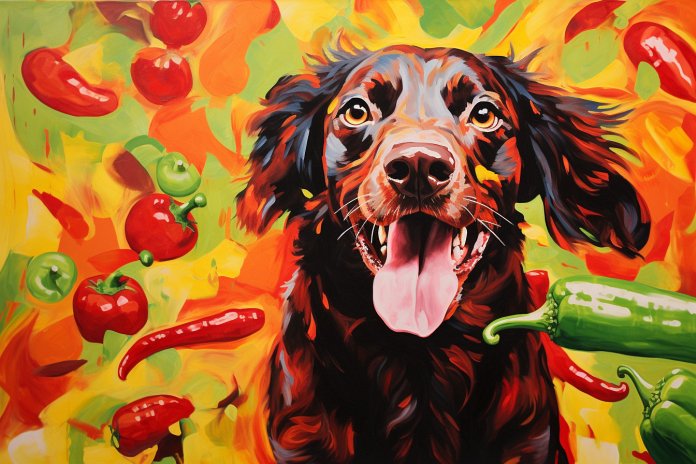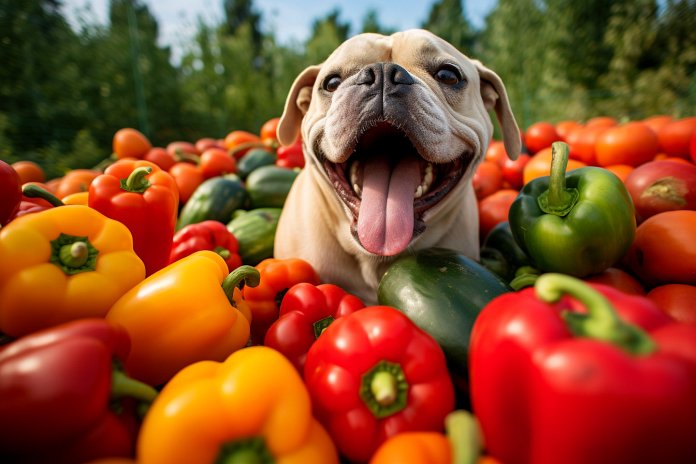
Bell peppers come in various colors, such as red, orange, yellow, and green. They are not only flavorful and sweet but also a healthy snack or addition to meals. Bell peppers are affordable and offer numerous health benefits. This raises the question of whether they are safe and beneficial for dogs to consume. In short, bell peppers are safe and healthy for dogs, but precautions should be taken to ensure their safety.
Signs of a Dog Enjoying Bell Peppers:
Bell peppers have a mild and sweet taste, making them a great option for dogs. Most dogs will enjoy the flavor and crunch of bell peppers, including cooked ones. However, every dog is different, and some may not take a liking to bell peppers. In such cases, it is best not to force them into their diet and consider alternative foods that offer similar benefits and are more appealing to your dog. Signs that your dog enjoys bell peppers include barking, whining, crying, staring, drooling, pacing, and pawing at you.
History of Dogs and Bell Peppers:
Bell peppers have been around for centuries, with prehistoric remains found in Peru. They were later popularized in Europe by Columbus in 1493, although the variety available at the time was different from the bell peppers we know today. Mass production and cultivation of bell peppers in the United States began in the 1920s. While there is limited recorded history regarding bell peppers and dogs, it is unlikely that dogs had access to or developed a taste for peppers thousands of years ago. Bell peppers remain an uncommon addition to a dog’s diet.
Science Behind Dogs and Bell Peppers:
Despite not being a common vegetable for dogs, bell peppers offer several health benefits. They contain Vitamin A, lutein, Vitamin E, and B6, which support eyesight, a strong immune system, healthy fur and skin, and a healthy nervous system. With only 30 calories per cup and about 93% water content, bell peppers are a low-calorie and nutrient-rich option for dogs.
Feeding Your Dog Bell Peppers:
When adding bell peppers to your dog’s diet, you can choose to cook them or serve them raw. Proper preparation involves removing the seeds, white membrane, and tough stem. Cooking the peppers is recommended for dogs with chewing issues or those who are young or older, as raw peppers can be harder and crunchier. Cooking also aids digestion, particularly for dogs with difficulty digesting high-fiber foods. Start with smaller amounts of bell peppers and monitor your dog for any adverse reactions. If you notice changes in bowel movements, such as loose stools, discontinue feeding them peppers. Red bell peppers, which contain high levels of beta-carotene, are recommended for their superior nutritional benefits, especially for older dogs with arthritis-related inflammation.
“Discover the health benefits of bell peppers for dogs and how to safely incorporate them into their diet.”

Tips & Things to Know
1️⃣ Bell peppers are safe and healthy for dogs to eat, but it’s important to introduce them gradually and monitor for any adverse reactions or changes in bowel movements.
2️⃣ Dogs may show signs of liking bell peppers, such as staring, alertness, barking, wagging tail, lip licking, drooling, stalking, and raising their paw.
3️⃣ If your dog doesn’t like bell peppers, don’t force them to eat it. There are other foods with similar benefits that your dog may prefer.
Frequently Asked Questions, Answered ✅
1. Are bell peppers safe for dogs to eat?
– Yes, bell peppers are safe for dogs to eat and can be a healthy snack or addition to their meals.
2. How can I tell if my dog likes bell peppers?
– Signs that your dog likes bell peppers include barking, whining, drooling, pacing, staring at you while you have the food, and pawing at you.
3. What are the health benefits of bell peppers for dogs?
– Bell peppers contain vitamins A, E, and B6, which support eyesight, a strong immune system, and healthy fur and skin. They are also low in calories and high in water content.
4. Should I cook bell peppers before giving them to my dog?
– It depends on your dog’s preferences and needs. Cooked peppers are softer and easier to digest, making them a better option for dogs with chewing issues or older dogs. However, raw peppers can also be given if your dog has no trouble chewing.
5. Which color of bell pepper is the most nutritious for dogs?
– Red bell peppers have the most nutritional benefits and contain high levels of beta-carotene, making them a great choice for dogs.